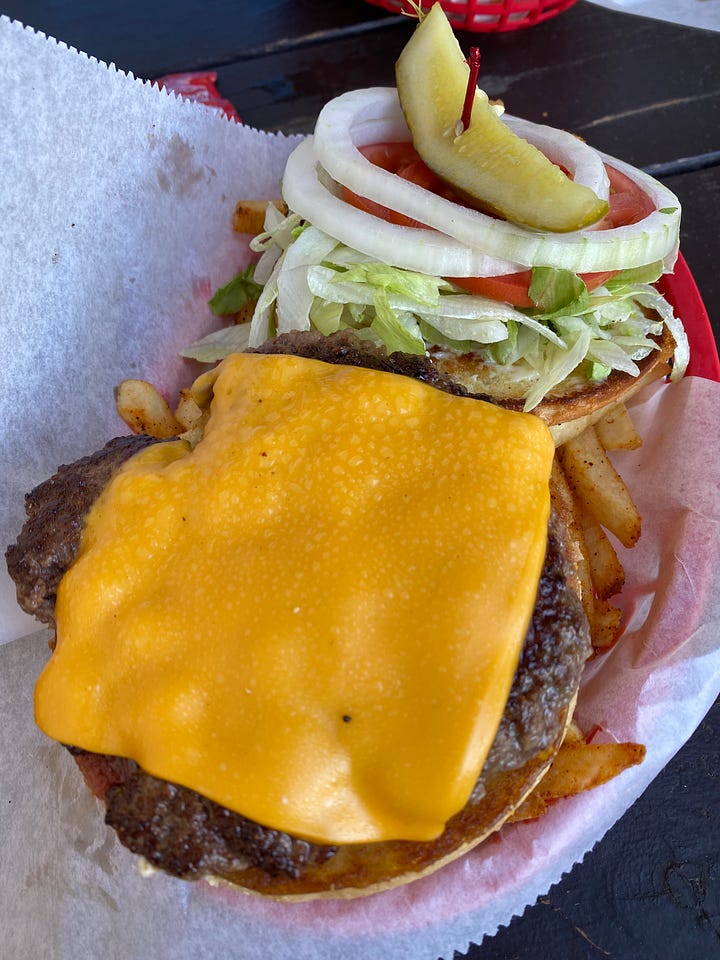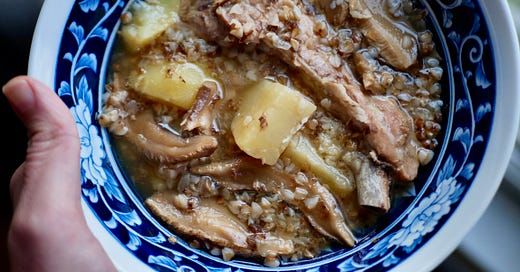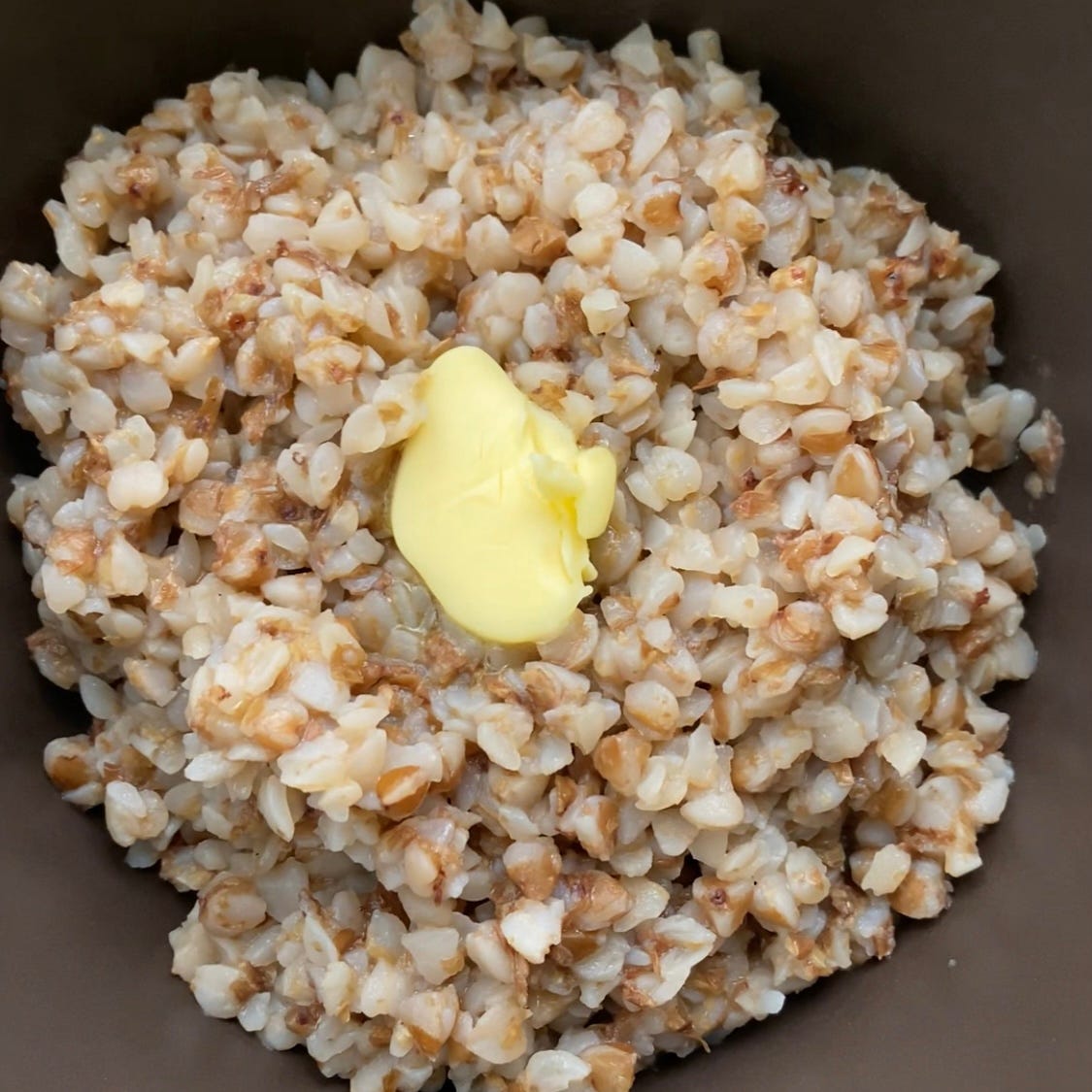A Case for Eating More Buckwheat!
My super easy recipe and process for perfect buckwheat every time.
Thank you for being a free subscriber! If you’re enjoying this newsletter, please consider becoming a paid subscriber.
I love buckwheat—as does, I think, every Ukrainian. Some of the things I love about it are the taste; nutty yet subtle, the texture; soft but firm (similar to rice), and, of course, its insane versatility as a pantry item. Buckwheat can be a perfect side dish, main course, or even dessert and it can be served during any meal of the day be it breakfast, lunch, or dinner! When buckwheat is toasted it takes on a nutty flavor and become very aromatic.
I have been sharing my love for this food for years now, so I was thrilled to see it included as one of the food trend predictions for the year 2024 in the New York Times’ article “9 Predictions for How We’ll Eat in 2024” by Kim Severson. Honestly, I have been trying to generate interest in buckwheat in this county for years now! Maybe all my hard work is finally paying off? I’d like to think so, but let’s be honest that it was only a matter of time before everyone discovered the joys of buckwheat. So as an early and diehard champion of buckwheat, I’m thrilled to be talking about this lovely ingredient again and again…and again and again!

What is buckwheat? There are a lot of misconceptions, so let’s start by explaining a few noteworthy facts. Despite its name, buckwheat is not a wheat or even a cereal. Harvard Health Publishing writes:
“It's not even a grain but rather a seed that's harvested from a flowering plant related to rhubarb.”
Yes, you read that correctly. Buckwheat is a seed that’s related to rhubarb and sorrel, not wheat! I mean, are we really surprised that it’s related to the delicious, amazing and glorious sorrel and rhubarb? Discovering that buckwheat is in fact a seed, we also learn that buckwheat is gluten-free—and so it’s accessible to everyone including those with gluten intolerance or celiac disease. Additionally, it is an incredibly nutritious and environmentally friendly crop—it is especially rich in protein and fiber. Those of us who are climate-minded will also appreciate the fact that it is commonly used as a cover crop. According to the Sustainable Agriculture Research & Education (SARE) Outreach,
A cover crop is a plant that is used primarily to slow erosion, improve soil health, enhance water availability, smother weeds, help control pests and diseases, increase biodiversity and bring a host of other benefits to your farm.
This means that, if we can get more people to eat and buy buckwheat, we can encourage the planting of buckwheat which can help with pest management, weed management, and crop diversity. As a crop, buckwheat grows quickly, requires less water, out competes weeds and is naturally resilient to pests and so it requires less maintenance and discourages the use of chemical pest control. However, apparently deer and turkey have a special affinity for buckwheat—who can blame them? Some research even suggests that using cover crops such as buckwheat increases the yield of other crops such as corn, soybeans, etc. The nectar from buckwheat flowers makes a dark-colored honey. Ukrainian recipes often call for buckwheat honey.

In Ukraine, buckwheat is called, гречана крупа or hrechana krupa. In the U.S., it is often referred to as kasha. In Ukraine, the word kasha can refer to any cooked cereal or grain porridge: millet, wheat berries, barley, corn, and so forth. However, buckwheat kasha is probably the most popular nationally although of course this varies drastically across different regions/oblasts in Ukraine.
Buckwheat, as you can imagine, is one of the most important staples of Ukrainian cooking and baking. The use of buckwheat has ancient roots in Ukraine—probably due to its relatively easy sowing, growth and cultivation cycle. It was a staple meal of Ukrainian peasants. We can think of this most important and beloved buckwheat kasha side dish as one would think of rice in other regions of the globe. Yet with the slightest of preparation, our side dish transforms into a hearty and nutritious meal through the addition of, let’s say, sautéed mushrooms, small pieces of meat/lard/liver or caramelized onions. The next time you are making mashed potatoes, pause and consider replacing those with buckwheat. Most of the time you can (unless of course you have an insane craving for mashed potatoes). Honestly, I would recommend everyone to add it to your menu for next thanksgiving since it is especially good with a big dollop of gravy and loves to soak up drippings!
In addition to being a stellar side dish, buckwheat has an extensive culinary utility in Ukrainian cuisine. It is used for fillings in dishes such as savory baked pies (Yavorivs'kiy check out my friend’s Anna’s version), fried hand pies, stuffed cabbage/peppers/tomatoes/beet leaves (check out my friend Olia’s stuffed beet rolls), varenyky, sausage, patties, fritters, as well as soups and stews. In soups, buckwheat especially pairs well with pork/bacon, mushrooms, sauerkraut, and sorrel. The nuttiness of the buckwheat pairs brilliantly with the smokiness of the bacon, for example, or cuts through the sharp tartness of fresh sorrel.
Finally, you can’t talk about buckwheat and its role in Ukrainian cuisine without talking about buckwheat flour. Buckwheat flour was incredibly popular in Ukraine especially in the 19th century or before the industrialization of the 20th century. In the early 20th century, highly processed white wheat flour became more easily available thus becoming the flour of choice transcending previous socioeconomic barriers. Traditionally buckwheat and its flour was considered the food of servants/serfs/peasants. Wheat, on the other hand, was the preferred flour of the elites. This was closely related to various agrarian taxation laws.
The production of buckwheat did not only decline in Eastern Europe but in Western Europe as well during the 20th century. For example, buckwheat growth reached its peak in 19th century France. According to some historical records, roughly 600,000 hectares of buckwheat was grown in France in the year 1890. In 2003, only 2,750 hectares are dedicated to producing buckwheat. In Ukraine, buckwheat flour was and continues to be used to prepare a wide assortment of baked goods including: buckwheat rolls called hrechanyky, pampushky (doughnuts), pyrihy (pies), pyrizhky (individual pies), nalysnyky (crepes), varenyky dough or halushky (dumplings), and…well…you get the idea. Buckwheat flour was often mixed with wheat flour to make breads, buns, babas (cakes), babkas, kolaches, and more.
I am so excited to continue sharing buckwheat and buckwheat flour recipes with y'all!
A SUPER EASY WAY TO PREPARE BUCKWHEAT:
Buckwheat Kasha or Hrechana Kasha
Little known fact, traditionally buckwheat kasha is cooked with the use of a raw egg, it’s 1 egg for each cup of buckwheat. The egg helps prevent the groats from sticking to one another and ensures separated grains. I will say that the egg method gives the final product a different texture and flavor. I strongly encourage you to try both versions especially if you want to add some extra protein to the mix. I always like to save a step so I skip the extra steps of beating and roasting the egg-covered buckwheat by cooking my buckwheat directly in water, stock, or sometimes milk as you would with different styles of rice for example. The ratio for cooking perfect buckwheat is ALWAYS 1:2! One part buckwheat to two parts water. You can use whatever container your heart desires but the ratio always stays the same, 1 to 2.
Where to Buy Buckwheat and Buckwheat Flour in Austin:
You can buy several brands of buckwheat at Borderless European Market (BEM) and Phoenicia Bakery & Deli.
You can buy buckwheat flour at Barton Springs Mill and Central Market.
Serving Ideas:
Make a meal by adding caramelized onions and/or fried bacon or smoked pork belly or even guanciale.
Vegetarians can enjoy it with sautéed mushrooms or any other seasonal veggies/tofu.
You can serve buckwheat alongside some grilled fish, sautéed chicken, roasted duck, fried pork chop, liver, or stewed lamb.
Remember, buckwheat is especially great for soaking up flavors and juices from rich dishes including things like mushroom gravy.
Ingredients:
1 cup roasted buckwheat
2 cups of water
4 tablespoons high fat butter or 1 tablespoon unrefined sunflower oil (to taste)
salt for seasoning (be generous)
Method:
Put buckwheat in a pot and cover with two cups of water.
Place the pot on the stove and bring to boil over high heat.
Once boiling, lower the heat to low, cover, and cook for 15 minutes.
Check to make sure all of the water has been absorbed, now take off heat and let sit covered for 5 minutes.
Now generously season with salt and add in the butter. Gently stir everything together until the butter is melted.
Serve with a little knob of butter.
FAVORITE BITE THIS WEEK
Classic American Cheeseburger from Billy’s on Burnet
A super old school spot that no one seems to ever mention when talking about the best burgers in Austin. I personally think that’s a huge miss on their part. The burgers here are perfectly cooked, the ratio of bun to burger is spot on, the fries are always well seasoned, and the toppings are fresh and well distributed. This, to me, is a quintessential American cheeseburger.
Price: $12.50 1/3 lb 100% beef burger with fries and pickle spear. You can sub the fries for a salad and get their whole wheat bun. I always get the white bun and french fries! I don’t know if anyone else noticed but it’s getting harder to find good fries in Austin.
They have a lunch special Monday-Friday $2 off all burgers from 11am to 2pm. Check out their menu for Happy Hour and other specials.
This place might not be “cool” or trendy but the food is always great!


I hope you enjoyed learning more about buckwheat from this week’s newsletter. Please tell me if you decided to cook or bake anything with this amazing ingredient in the comments! Also, what’s your favorite burger or veggie burger? It does not have to be in Austin.
Hope everyone has a lovely day!






Yes in praise of climate-smart buckwheat! I looove the tips of cooking buckwheat with an egg to keep the grains separated..or conversely, make mashed buckwheat in place of mashed potatoes!
We can never have too much buckwheat.